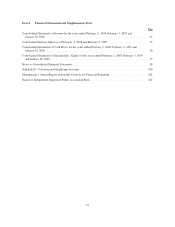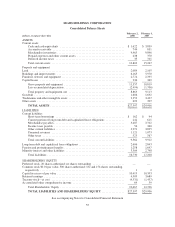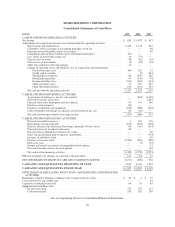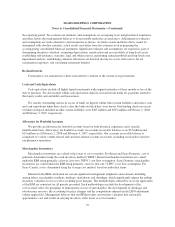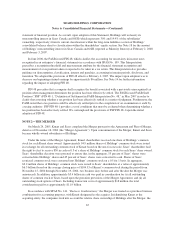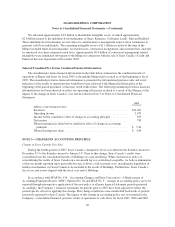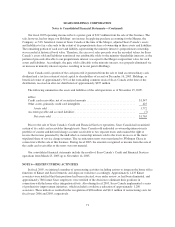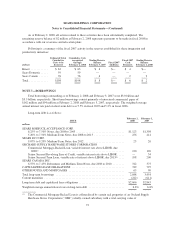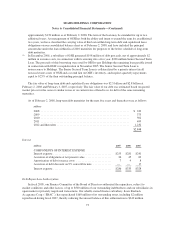Sears 2007 Annual Report Download - page 63
Download and view the complete annual report
Please find page 63 of the 2007 Sears annual report below. You can navigate through the pages in the report by either clicking on the pages listed below, or by using the keyword search tool below to find specific information within the annual report.SEARS HOLDINGS CORPORATION
Notes to Consolidated Financial Statements—(Continued)
For interest rate swaps and caps that have been designated and qualify as hedges, both the effective and
ineffective portions of the changes in the fair value of the derivative, along with the offsetting gain or loss on the
designated hedged item that is attributable to the hedged risk, are recognized in the consolidated statements of
income in the same account as the hedged item, as a component of interest expense. Changes in the fair value of
interest rate swaps and caps that do not qualify as hedges are recognized currently as a component of interest
expense. The foreign currency forward contracts are recorded on the consolidated balance sheet at fair value and,
to the extent they have been designated and qualify for hedge accounting treatment, an offsetting amount is
recorded as a component of other comprehensive income, net of income tax effects. Changes in the fair value of
those forward contracts for which hedge accounting is not applied are recorded in the consolidated statement of
income as a component of other income. Certain of our currency forward contracts require collateral be posted in
the event our liability under such contracts reaches a predetermined threshold. Cash collateral posted under these
contracts is recorded as part of our accounts receivable balance.
We, from time to time, invest our surplus cash in various securities and financial instruments, including total
return swaps, which are derivative instruments designed to synthetically replicate the economic return
characteristics of one or more underlying marketable equity securities. Such investments may be highly
concentrated and involve substantial risks. Changes in the fair value of the total return swaps are recognized as a
component of interest and investment income in our consolidated statements of income as they occur. As of
February 2, 2008 we had no investments in total return swaps.
Fair Value of Financial Instruments
Cash and cash equivalents, accounts receivable, merchandise payables, credit facility borrowings and
accrued liabilities are reflected in the consolidated balance sheet at cost, which approximates fair value due to the
short-term nature of these instruments. The fair value of our debt and derivative financial instruments are
disclosed in Note 7 and Note 8, respectively.
Financial instruments that potentially subject Holdings to concentration of credit risk consist principally of
temporary cash investments, accounts receivable and derivative financial instruments. We place our cash and
cash equivalents in investment-grade, short-term instruments with high quality financial institutions and, by
policy, limit the amount of credit exposure in any one financial instrument. We use high credit quality
counterparties to transact our derivative transactions.
Self-insurance Reserves
We are self-insured for certain costs related to healthcare, workers’ compensation, asbestos and
environmental, automobile, warranty, product and general liability claims. We obtain third-party insurance
coverage to limit our exposure to certain of these self-insured risks. A portion of these self-insured risks is
managed through a wholly-owned insurance subsidiary. Our liability reflected on the consolidated balance sheet,
classified within other liabilities (current and long-term), represents an estimate of the ultimate cost of claims
incurred as of the balance sheet date. In estimating this liability, we utilize loss development factors based on
Company-specific data to project the future development of incurred losses. Loss estimates are adjusted based
upon actual claims settlements and reported claims. The liabilities for self-insured risks are discounted to their
net present values.
Loss Contingencies
We account for contingent losses in accordance with SFAS No. 5, “Accounting for Contingencies.” Under
SFAS No. 5, loss contingency provisions are recorded for probable losses at management’s best estimate of a
63


